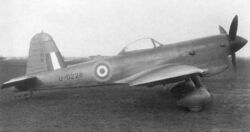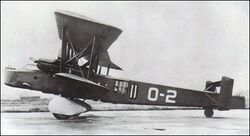Engineering:United Kingdom aircraft test serials
United Kingdom aircraft test serials are used to externally identify aircraft flown within the United Kingdom without a full Certificate of Airworthiness.[1] They can be used for testing experimental and prototype aircraft or modifications, pre-delivery flights for foreign customers and are sometimes referred to as "B" class markings.[1]
1930s
An initial set of markings was introduced in 1929, each company was allocated a letter to which would follow a number, sometimes with a hyphen or a gap between.[1] For example, A was allocated to the Armstrong Whitworth Aircraft and A 1 was used in March 1930 on an Armstrong Whitworth Starling.[1] Sometimes Hawker and Vickers would also add the letters PV to the markings to indicate a private venture (that is a type in development not paid for by the Air Ministry).[1]
1940s

The presentation was changed to look like a military serial for security reasons during the Second World War.[1] For example, the prototype de Havilland Mosquito was allocated test markings E-0234.
1948
Following a change back to the original system in 1946 a new system was introduced on 1 January 1948.[1] Each company was allocated a number which followed the British nationality marking G and then followed by an individual identity number.[1] For example, Blackburn Aeroplane & Motor Company were allocated G-2 and the first allocation G-2-1 was used on a Miles Messenger used as an engine testbed for the Cirrus Bombardier.[1] Companies could allocate and re-use the identities as they liked, some ran in sequence from 1 and others used the aircraft manufacturers serial number as part of the marking, for example G-51-200 was a Britten Norman Islander with a manufacturers serial number of 200.[1] Allocations of codes from defunct companies have been reallocated.
Letter sequence 1929–1947
| Allocation | Company | Notes |
|---|---|---|
| A | Armstrong Whitworth Aircraft | Replaced by G-1 in 1948 |
| B | Blackburn Aeroplane & Motor Company | Replaced by G-2 in 1948 |
| C | Boulton Paul | Replaced by G-3 in 1948 |
| D | Portsmouth Aviation | Replaced by G-4 in 1948 |
| E | de Havilland | Replaced by G-5 in 1948 |
| F | Fairey Aviation | Replaced by G-6 in 1948 |
| G | Gloster Aircraft | Replaced by G-7 in 1948 |
| H | Handley Page | Replaced by G-8 in 1948 |
| I | Hawker Aircraft | Replaced by G-9 in 1948 |
| J | Parnall Aircraft | Out of use by 1946 |
| J | Reid & Sigrist | From 1947, replaced by G-10 in 1948 |
| K | Avro | Replaced by G-11 in 1948 |
| L | Saunders-Roe | Replaced by G-12 in 1948 |
| M | Short Brothers | Replaced by G-14 in 1948 |
| N | Supermarine | Replaced by G-15 in 1948 |
| O | Vickers Armstrongs | Replaced by G-16 in 1948 |
| P | Westland Aircraft | Replaced by G-17 in 1948 |
| R | Bristol Aeroplane | Replaced by G-18 in 1948 |
| S | Spartan Aircraft | Out of use by 1936 |
| S | Heston Aircraft | Replaced by G-19 in 1948 |
| T | General Aircraft | Replaced by G-20 in 1948 |
| U | Phillips & Powis later Miles Aircraft | Replaced by G-21 in 1948 |
| V | Airspeed | Replaced by G-22 in 1948 |
| W | G & J Weir | 1933–1946 |
| X | Percival Aircraft | Replaced by G-23 in 1948 |
| Y | British Aircraft Manufacturing | Out of use by 1938 |
| Y | Cunliffe-Owen | 1940–1947, replaced by G-24 in 1948 |
| Z | Auster Aircraft | Replaced by G-25 in 1948 |
| AB | Slingsby Sailplanes | Replaced by G-26 in 1948 |
Numeric sequence since 1948
| Allocation | Company | Notes | |
|---|---|---|---|
| G-1 | Armstrong Whitworth Aircraft later Hawker Siddeley Aviation | 1948–1967 | |
| G-1 | Rolls-Royce | Since 1969 | |
| G-2 | Blackburn Aircraft later Hawker Siddeley Aviation | Used at Brough | |
| G-3 | Boulton Paul | ||
| G-4 | Portsmouth Aviation | 1948–1949 | |
| G-4 | Miles Aviation | Since 1969 | |
| G-5 | de Havilland later Hawker Siddeley Aviation | Used at Hatfield then Chester | |
| G-6 | Fairey Aviation later Westland Helicopters | ||
| G-7 | Gloster Aircraft | 1948–1961 | |
| G-7 | Slingsby Sailplanes | Since 1971 | |
| G-8 | Handley Page | 1948-1970 | |
| G-9 | Hawker Aircraft later Hawker Siddeley Aviation | Mainly used on Hawker Hunters and Hawker Sea Fury's | |
| G-10 | Reid & Sigrist | 1948–1953 | |
| G-11 | Avro later Hawker Siddeley Aviation | Used at Woodford | |
| G-12 | Saunders-Roe later Westland Aircraft then British Hovercraft Corporation | G-12-1 was used on the first practical hovercraft, the SR-N1; G-12-1 had been used previously on the Saro SR/A1 | |
| G-13 | Not used | ||
| G-14 | Short Brothers | ||
| G-15 | Supermarine | 1948–1968 | |
| G-16 | Vickers-Armstrongs later British Aircraft Corporation | ||
| G-17 | Westland Aircraft later Westland Helicopters | ||
| G-18 | Bristol Aeroplane later British Aircraft Corporation | Used at Filton (Bristol) and Oldmixon (Weston-super-Mare) | |
| G-19 | Heston Aircraft | 1948–1960 | |
| G-20 | General Aircraft | 1948–1949 | |
| G-21 | Miles Aircraft later Handley Page Reading | 1948–1963 | |
| G-22 | Airspeed | 1948–1952 | |
| G-23 | Percival Aircraft later British Aircraft Corporation | 1948–1966 | |
| G-24 | Cunliffe-Owen Aircraft | 1948–1949 | |
| G-25 | Auster Aircraft | 1948–1962 | |
| G-26 | Slingsby Sailplanes | 1948–1949 | |
| G-27 | English Electric later British Aircraft Corporation | ||
| G-28 | British European Airways later British Airways Helicopters | ||
| G-29 | D. Napier & Son | 1948–1962 | |
| G-30 | Pest Control Limited | 1952–1957 | |
| G-31 | Scottish Aviation | ||
| G-32 | Cierva Autogiro Company | 1948–1951 | |
| G-33 | Flight Refuelling Limited | 1948–1972 | |
| G-34 | Chrislea Aircraft | 1948–1952 | |
| G-35 | F.G Miles then Beagle Aircraft | 1951–1970 | |
| G-36 | College of Aeronautics then Cranfield Institute of Technology | Since 1954 | |
| G-37 | Rolls-Royce | Used at Hucknall 1954–1971 | |
| G-38 | de Havilland Propellers later Hawker Siddeley Dynamics | 1954–1975 | |
| G-39 | Folland Aircraft | 1954–1965; G-39-1 was used on the prototype Folland Midge | |
| G-40 | Wiltshire School of Flying | ||
| G-41 | Aviation Traders | 1956–1976 | |
| G-42 | Armstrong Siddeley Motors | 1956–1959 | |
| G-43 | Edgar Percival Aircraft | 1956–1959 | |
| G-44 | Agricultural Aviation Limited | 1959 | |
| G-45 | Bristol Siddeley Engines | 1959–1969 | |
| G-46 | Saunders-Roe later Westland Aircraft | 1959–1962 | |
| G-47 | Lancashire Aircraft | ||
| G-48 | Westland Aircraft later Westland Helicopters | 1960–1969 | |
| G-49 | F G Miles Engineering | 1965–1969 | |
| G-50 | Alvis | ||
| G-51 | Britten Norman | Since 1967 | |
| G-52 | Marshall of Cambridge | ||
| G-53 | NDN Aircraft | ||
| G-54 | Cameron Balloons[2] | ||
| G-55 | W Vinten[2] | ||
| G-56 | Edgley Aircraft[2] | ||
| G-57 | Airship Industries[2] | ||
| G-65 | Solar Wings[2] | ||
| G-76 | Police Aviation Services Limited | ||
| G-77 | Thruster Air Services Ltd | ||
| G-78 | Bristow Helicopters Limited | ||
| G-79 | Eurocopter Oxford[2] | ||
| G-80 | British Microlight Aircraft Association Ltd | ||
| G-89 | Cosmik Aviation Limited |
See also
- British military aircraft designation systems
- List of RAF squadron codes
- Royal Air Force roundels
- United Kingdom aircraft registration
- United Kingdom military aircraft serial numbers
References
Bibliography
- Revell, D.S. (1978). P.H. Butler. ed. Under B Conditions. Liverpool, England: Merseyside Aviation Society. ISBN 0-902420-24-0.
- Michael Austen, ed (1999). The British Civil Aircraft Register 1919-1999. Tonbridge, Kent, England: Air-Britain. ISBN 0-85130-281-5.
 |


